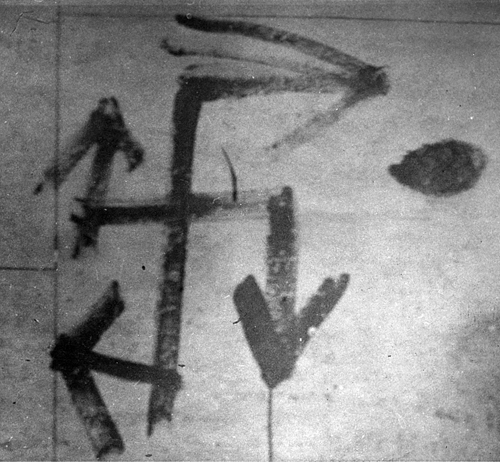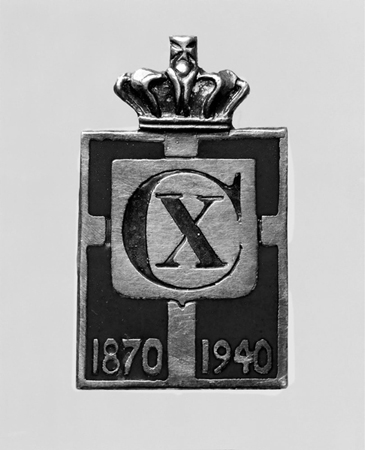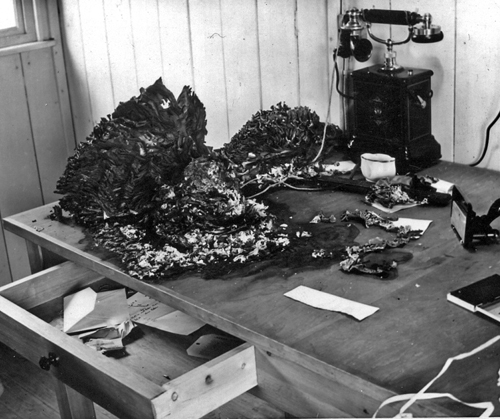

The Churchill Club’s insignia, painted everywhere. “This flame of rebellion kills Nazis,” it proclaimed
In January 1942, Denmark was in its second year of German occupation. Danish citizens expressed their opposition to Germany not by fighting back, but by making gestures of national pride. Some gathered in public spaces to sing Danish folk songs. Some purchased “King’s Badges,” offered in jewelry shops in silver or gold, as a symbol of solidarity with the government. Some students refused to speak German in language classes.
Meanwhile, German soldiers settled in. Month by month the occupiers grew ever more comfortable in Denmark, trading freely with merchants and learning to savor the country’s food and culture. Some Danish manufacturers collaborated with their “protectors” by making weapons and parts to facilitate German war plans. Others created temporary housing for the soldiers. One manufacturer, the Riffel Syndicate in Copenhagen, took an order to make five thousand machine guns for the Germans, who paid for it with funds drawn from the Danish National Bank. There was money to be made all around.
In this atmosphere, the Churchill Club began its activities.

A King’s Badge
KNUD PEDERSEN: We started our Churchill Club work with a series of daylight raids on German directional signs in Aalborg, as we had in Odense. Often we worked in pairs. With a shrill whistle one would distract a soldier into leaving his post while the other slipped behind and twisted the sign around so that German troops and wagons would circulate to the wrong places. Sometimes we smashed signs to the ground with hammers. The Germans would put them back up, and we would take them back down again. These exercises weren’t winning the war, but we were getting practice and our actions were noticed by the people in the streets. Someone was not giving in.
The sign raids also gave us experience working with the threat of arrest hanging over our heads, or the prospect of being shot. You had to get used to it. You had to learn to breathe around armed soldiers. Your body works differently in an atmosphere of danger or excitement. Even the smallest of missions can send your diaphragm into spasms when you have no experience. You start to breathe too fast. Some people laugh uncontrollably. The tongue loosens. Some say things they regret. Ours was a war without fronts, meaning the enemy was 360 degrees around us at all times. Even with our parents, teachers, and classmates, we had to be careful what we said and whom we said it to.
* * *
By February, the walls of Aalborg were sticky with blue Churchill Club paint and the German directional signs looked like pretzels. Knud and the other young saboteurs were ready for a bigger target. One candidate was obvious: there was no better-known German collaborator in Aalborg than the Fuchs Construction Company. It built hangars, runways, and office buildings at the Aalborg airport for the German military, receiving handsome profits as it helped the Third Reich make more and more flights to battered Norway. The Fuchs Company was a prime example of everything the Churchill Club hated about the Danish government’s compliant posture.
At the Aalborg airport, the company’s headquarters was isolated from the terminal and runways. The boys decided to set it ablaze.
KNUD PEDERSEN: Eigil, Helge, Børge, and I went out to perform the raid on a bitterly cold winter evening. It was Eigil’s initiation night. If he did well and the operation succeeded, he would become a full-fledged Churchill Club member.
We told our parents we would be playing bridge to gain a few hours more to strike under the cover of darkness. We met outside the monastery and took off two by two toward the most dangerous place in town. The Limfjorden Bridge connects Aalborg with the neighboring town of Noerresundby, spanning a fjord. Because the airport, on the Noerresundby side, was so important to the Germans, they posted armed guards at checkpoints on both sides to examine vehicles. We were waved through both checkpoints without incident and continued north along snow-lined streets out into the countryside.
A few miles later the hulking shapes of the Aalborg airport hangars came into view. The snow-covered airfield, behind a wire fence, looked like a farm, dotted with livestock. But the animals never moved. They were the Germans’ wooden decoys, made to create the impression from the air that the traveler was passing over pasturelands rather than airfields of military importance. There was a manned guard post at the main entrance to the airport, but the Fuchs office was off to the side in a darkened region of the facility. The wire fence with the NO UNAUTHORIZED PERSONNEL sign was easy to cut through.
We crept up to the Fuchs headquarters and stood still. There were no lights on inside, and—thankfully—no guard dogs. We stood motionless in the dark for several minutes, listening for a sound of any kind and hesitating, struggling to summon up the courage to do the job and privately reminding ourselves that we could still turn back. Then suddenly Børge grabbed a stick and smashed out three windows. It made a huge noise! When I looked at Eigil I saw a wet stripe running down his trousers.
We went through the windows and found ourselves inside an office filled with desks and drawing tables, lined up in rows. Architectural drawings were stacked on one of the tables. Bills and receipts were held in place by a paperweight on a second desk. Another supported a pile of business cards that read: “You have been visited by a member of the Nazi party.”
Overlooking all the desks and chairs was a large framed photo of Adolf Hitler. He glared down coldly at us, as if he knew who we were. We began our own work by liberating the führer from his nail on the wall and smashing him over a desk. Glass flew everywhere. We slammed the portrait onto the floor and took turns dancing on his face. We then gathered all the drawings and receipts and business cards into a single pile, placed what was left of Hitler on top like a cherry on a cake, and placed a pillow atop the whole stack. Just before we lit it we carried out a typewriter—a very useful machine that was difficult to find and almost impossible to buy. We also carried away what turned out to be a leveling machine. We didn’t know what to do with it, but it looked promising. Then we put a match to the whole traitorous mess and made a run for our bikes. On our way back we looked behind us and saw a glow forming bright against the darkness through a window. It was a beautiful sight!
At the next day’s Churchill Club meeting the others asked if we had left a calling card taking credit for the attack. No, we said, why would we do that? Well, what would keep the Fuchs stooges from assuming they had been raided by common criminals, not patriots? Hard as it was to swallow, our colleagues were right. We had not made it clear that collaboration central had been visited by Danish patriots who would never give in. So we took a sledgehammer and wrecked the leveling machine we had stolen—we couldn’t figure out what it did anyway—and wrote a message on it: “Get out of our country, you stinking Nazis.” A few nights later we bicycled back out to return the wrecked machine to them, with our autograph. We discovered that the Fuchs office hadn’t burned down—the building was standing. But it was still satisfying to know that we had destroyed their plans, blueprints, and records, which meant that they would have to start over.
And we had greatly improved Hitler’s looks.

Crime scene photograph of the damage at the Fuchs Construction Company showing ashes of destroyed design drawings for new airport hangars